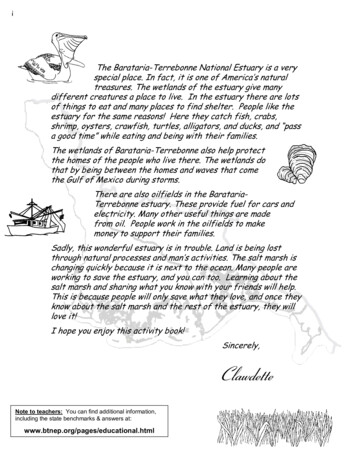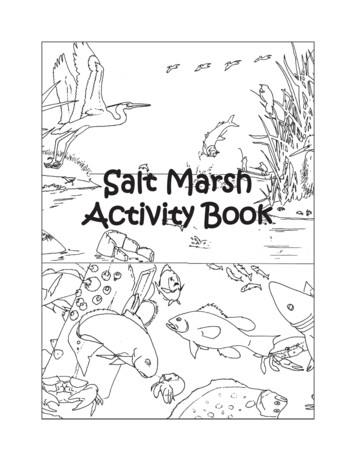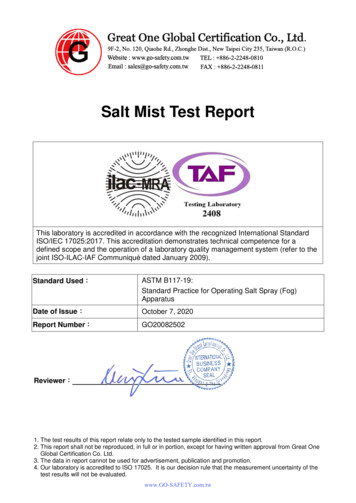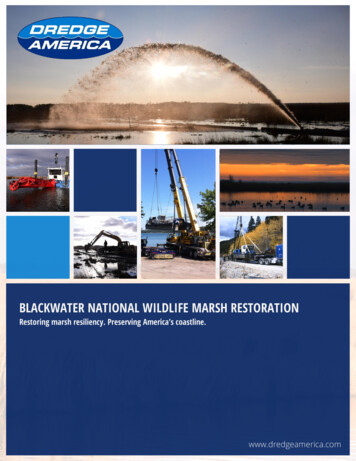
Transcription
iThe Barataria-Terrebonne National Estuary is a veryspecial place. In fact, it is one of America’s naturaltreasures. The wetlands of the estuary give manydifferent creatures a place to live. In the estuary there are lotsof things to eat and many places to find shelter. People like theestuary for the same reasons! Here they catch fish, crabs,shrimp, oysters, crawfish, turtles, alligators, and ducks, and “passa good time” while eating and being with their families.The wetlands of Barataria-Terrebonne also help protectthe homes of the people who live there. The wetlands dothat by being between the homes and waves that comethe Gulf of Mexico during storms.fromThere are also oilfields in the BaratariaTerrebonne estuary. These provide fuel for cars andelectricity. Many other useful things are madefrom oil. People work in the oilfields to makemoney to support their families.Sadly, this wonderful estuary is in trouble. Land is being lostthrough natural processes and man’s activities. The salt marsh ischanging quickly because it is next to the ocean. Many people areworking to save the estuary, and you can too. Learning about thesalt marsh and sharing what you know with your friends will help.This is because people will only save what they love, and once theyknow about the salt marsh and the rest of the estuary, they willlove it!I hope you enjoy this activity book!Sincerely,ClawdetteNote to teachers: You can find additional information,including the state benchmarks & answers at:www.btnep.org/pages/educational.html
Table of ContentsPreface: Letter from Clawdette . . .iIntroduction . . . 1Activities:What is an Estuary? . 2Clawdette, Where is the Barataria-Terrebonne Estuary? .3The Story of My Life. . .4Birds of a Different Feather . . .8Bill Bits . . 9#Fish Apart, Fish Together . . 13Fish Pieces . . . .29The Spongy Marsh . . . .20* From Marsh to Marina . . . . . .21Water Pieces . . .33Why Are We Losing Salt Marsh? .24Coloring Pages:Blue Crabs . . . . .6Brown Pelicans . . . .7Gulf Fritillary Butterfly . . . .10Diamondback Terrapin . . . . . . 11Let’s Go Fishing . . . . . .14Black Mangroves . 12Plants and Phytoplankton . . . . . . .16Zooplankton . . .17Food Pyramid of the Salt Marsh . . .18How the Salt Marsh Stays Healthy . . .19Glossary . .26Activity was adapted from the Take-Apart Fish Puzzle developed at the Helen Shedd Keith Aquatic ScienceCenter of the John G. Shedd Aquarium, Chicago, Illinois.#*Activity from Wading into Wetlands Issue of Nature Scope by National Wildlife Federation reprinted withpermission from McGraw-Hill Co.
1My name is Clawdette.I live in the salt marsh of theBarataria-Terrebonne National Estuary.Come see!I would like to introduce you tomy home and some friends wholive there with me.
4My name is Clawdette, and I am afemale blue crab. I began life as a tiny eggattached to my mother along withthousands of siblings in the Gulf ofMexico. Then I hatched as a zoea larva. Inthe deep water, there was plenty of food toeat, so I grew even bigger. As I continued togrow and became a megalops larva, I wasstrong enough to start to swim inlandtowards the salt marsh. During my next stage,I became an immature blue crab. As animmature crab,I swam to the saltmarsh edge andfound marsh grassesto shelter mefrom animals thatwanted to eat me. Now I am a mature bluecrab and live in the salt marsh. In thesummer, I will travel to the deep offshorewaters to lay my own eggs. Then the cycle willbegin again.
5Draw a line to show where I livedin each life stage.Clawdette’slife stagesGulf of MexicoEggBarrier IslandZoeaLarvaSalt marsh edgeMegalopsLarvaImmatureBlue CrabThe salt marshAdultBlue Crab
6This is my sister, Shelby. Female blue crabs likeShelby and me have red claws. Male blue crabs haveblue claws. This is a way to tell the differencebetween females and males.
7C H O V I ESNMULLEATMENHADENMENHADENMSUELLETA N C H O V IHere is a brown pelican, Louisiana’s state bird. Pelicans canhold 21/2 gallons of water in their pouch! This one just caughta fish. Can you find the fish in its pouch? Brown pelicans liketo eat fish such as mullet, menhaden, and anchovies.
10Here is a gulf fritillary butterfly sitting on a plant called a salt marsh aster.Gulf fritillaries eat salt marsh asters. They lay their eggs on passion flowerleaves (maypops). The eggs hatch into caterpillars. Caterpillars eat and eatpassion flower leaves until they become fat. In the fall they make a chrysaliswhich hangs from the plant. They stay in the chrysalis over the winter to restand change into adults. In the spring they hatch into adult butterflies.
11This is Freckles, a diamondback terrapin turtle. She lays her eggsinthe salt marsh. She swims around looking for food to eat.She ishappy because she likes to eat dragonflies. A dragonflyjustlanded on her nose.
13Fish Apart, Fish TogetherDorsal finEyeCaudal finNostrilLaterallineMouthGill coverAnal finPelvic finsPectoral finThere are many different kinds of fishthatyou can see in the salt marsh. All ofthe fishlook different. Fish eat a variety of foods from tinyplants to other fish. Some fish live on the bottomwhile other fish live near the surface. For all theirdifferences, all fish have the same parts. To find outthe function of the parts of a fish, go to the fishglossary on page 27.The parts of a fish are separated on pages 29 & 31.Cut them out and put the fish back together. Use theinformation on this page to help you out.Activity was adapted from the Take-Apart Fish Puzzle developed at the Helen Shedd Keith Aquatic Science Centerof the John G. Shedd Aquarium, Chicago, Illinois.
19sun lightclean airsalt marsh grasssedimentfresh waterfoodnutrientsfresh waterexercisenutrientssalt water from the tidesedimentJust as you need clean air to breathe, food to eat, water to drink,and exercise to grow and stay healthy, the salt marsh also hasneeds.The salt marsh needs fresh water moving from land to the sea tobring it nutrients and sediment. Salt marsh plants need thenutrients to grow just as you need food. Salt marsh plants also needsediment to have a place for their roots to grow. The tide pushessalt water into the salt marsh. Salt water brings with it morenutrients and soil. When the tide goes out to the sea, the salt waterdrains from the salt marsh. This action allows the fresh water fromthe land to move into the salt marsh on its way to the sea.
21The salt marsh can be a great place tomake a living! Hundreds of years agoNative Americans and some of the earliestEuropean settlers knew this. Today, manypeople still depend on the salt marsh tomake a living. In this activity, you will seehow humans have changed the marsh tomeet their needs over time.Follow the directions to figure out the orderof how this salt marsh becomes a marina.1. Go to this website:www.btnep.org/pages/educational.html2. Print out the Marsh to Marina activitypages.3. Color and cut out the pictures.4. On the following pages, paste the picturesin order from the earliest to present day.Reprinted with permission of McGraw-Hill Co. from Wading into Wetlands issue ofNature Scope by National Wildlife Federation .
24Land loss occurs through natural causes andman’s activities.1) Color the salt marsh on the following page. Go to page33, and color the water pieces, then cut them out.2) Read the following examples of causes for land loss inthe salt marsh.A)An Oil and Gas company digs a canal through the marshto look for oil to supply our nation with energy.B)A patch of salt marsh grass drowns from subsidence.C)Wake from boats traveling through the canal causes itto become wider.D)Tropical Storm Edgar pushes large waves towards themarsh causing erosion.3) On the salt marsh page, place a water piece on thelocation that matches the letter of the example.4) After the activity answer these questions.What does the marsh look like now?Will Ihave tomove?How does this affect you?If 4 acres of land are lost every 3 hours, how much saltmarsh would be lost to open water in 24 hours (1 day)?
26Bacteria (băk-tîr’ē-c): Tiny one-celled animals that can beseen under a microscope.Chrysalis (krĭs’c-lĭs): The skin that covers a caterpillar whileit changes into a butterfly.Detritus (dĭ-trī’tcs): Decaying plant material.Erosion (ĭ-rō’zhcn): The removal of sediments often throughthe action of water and wind.Estuary (ĕs’chc, werē):The place where fresh and salt watermix.Habitat (hăb’ĭ-tăt’): An area where an animal has food,water, shelter, and space to live.Nutrient (nü’trē, cnt): Something an animal needs for lifeand growth.Phytoplankton (fī’tō-plăngk’tcn): Tiny creatures found in thewater that use sunlight to store energy like plants.Pneumatophore (nü-măt’c-fôr’): Part of the black mangrovetree roots that stick out of the ground.Salt marsh (sôlt marsh): A kind of wetland covered by tallgrasses and salt water.Sediment (sedcm cnt): Material that is deposited by wateror wind, such as sand, silt, or clay.Subsidence (scb-sī’ dĕns): When the land becomes morepacked together, it sinks.Zooplankton (zō’c-plăngk’tcn): Tiny animals that float in thewater.
27Mouth- The mouth on a fish may be big or small, may face up ordown, may be long like a straw or short, and may stretch out.Nostril- Fish have noses, but not for breathing. Fish use theirnoses to smell chemicals and other fish in the water. Some fish cansmell things that are miles away.Eyes- Fish can have large eyes or small ones. There are many different eyecolors. One thing is for sure- most fish have blurry vision.Gill cover- This is a flap of skin and bone to protect the delicate gills foundunderneath. The gills of a fish are for breathing. The fish use the gills totake oxygen from the water.Caudal fin- This is the fish’s tail. Some fish move through the water bymoving their caudal fin back and forth. Some fish use the caudal fin as arudder to help guide them through the water and use their other fins formovement.Dorsal fin- Fish can have one dorsal fin, two, or none at all. Dorsal fins comein a variety of shapes and have many different uses.Anal fins- Sometimes anal fins have sharp projections on them to protectthe fish from predators.Pelvic fins- These fins are like the fish’s legs. They are used to fine tunemovement of a fish but can have a different function. In some fish pelvicfins are used to crawl along the bottom or to hold and grasp objects.Pectoral fins- These are like the fish’s arms. They are also used to finetune movement of a fish but can be used for a different function. Some fishdo not have pectoral fins.Lateral line- This is a special sense organ on a fish. Fish use the lateral lineto tell how deep it is in the water, what sounds are present, and to help it“see” in murky water. The lateral line is sensitive to chemicals in the waterand can sometimes sense electrical fields to make it work like radar. A fish,therefore, does not always depend on sight.Scales- Most fish have some sort of scales, but a few do not. Scales oftenfeel slimy. This “slime” protects a fish from infections due to cuts andscrapes.
AcknowledgementsThis book would not have been possible without the time andexpertise of the following:Elaine AngellozGwen EmickKeri TurnerLASIP Project Star Site CoordinatorCoordinatorAssociate InstructorNicholls State UniversityGovernor's Office of Environmental EducationNicholls State UniversityAline BarrLASIP Partnership CoordinatorDr. Jessica KastlerMarine Education InstructorLA. Univ. Marine ConsortiumJean May-BrettLA. Science Teachers AssociationThankYou!Dr. Earl MelanconDept. of BiologyNicholls State UniversityValerie ButlerJed PitreScience InstructorScience InstructorHahnville High SchoolThibodaux High SchoolDr. Rex CaffeyDeborah SchultzMarine Resource Economic SpecialistEducation CoordinatorLSU Agricultural CenterBTNEPJamie CheramieElementary EducatorKerry St. Pe’DirectorBTNEPThank you for reviewing this book: Anne Granier, Nathan Levy, and Laura St. Pe’All statistics in this booklet came from Barataria-Terrebonne National Estuary Program publications. Formore information visit the Barataria-Terrebonne NEP web site @ www.btnep.orgThis publication was partially funded by the United States Environmental Protection Agency and the LouisianaDepartment of Environmental Quality Grant #CE-006660. Additional support came from the Louisiana DeltaService Corps. The contents of this document do not necessarily represent views of the United StatesEnvironmental Protection Agency and the Louisiana Department of Environmental Quality, or the LouisianaDelta Service Corps. The mention of trade names or commercial products does not in any way constitute anendorsement or recommendation for use.This public document was published at a total cost of . copies of this public document werepublished at a cost of . This document was published by the Barataria-Terrebonne National EstuaryProgram, Nicholls State University Campus, P.O. Box 2663, Thibodaux, LA 70310, to provide the public withenvironmental information under the authority of La. R.S. 30:2011. This material was printed in accordancewith standards for printing by state agencies established pursuant to La. R.S. 43:31.
Louisiana State BenchmarksLife ScienceK-4LS-E-B1 – Observing and describing the lifecycles of some plants and animalsPages: 4,5, and 10LS-E-C3 – Observing animals and plants and describing interactions orinterdependencesPages: 10, 14, 15, 16, 18, 21, and 245-8LS-M-A3 – Observing and analyzing the growth and development of selectedorganisms, including a seed plant and insect with complete metamorphosis, and anamphibianPages: 4 and 10LS-M-C3 – Investigating major ecosystems, recognizing physical properties andorganisms within eachPages: 2, 3, and 19 physical, all animal pagesScience and the EnvironmentK-4SE-E-A1 – Understanding that an “ecosystem” is made of living and nonlivingcomponentsPages: The book as a whole describes the salt marsh ecosystemSE-E-A3 – Identifying ways in which humans have altered their environment,both in positive and negative ways either for themselves or for other living thingsPages: 21-23, and 245-8SE-M-A1 – Demonstrating knowledge that an ecosystem includes living andnonliving factors and that humans are an integral part of that ecosystemPages: The book as a whole, especially the prefaceSE-M-A10 – Identifying types of soil erosion and preventative measuresPage: 24
AnswersPage 5.Draw a line from:Egg and Zoea to Gulf of MexicoMegalops to Barrier IslandImmature Blue Crab to Salt Marsh EdgeAdult Blue Crab to The Salt MarshPage 7.Fish located in bottom of pelican’s pouch.Page 8.The double crested cormorant is different from the greategret because it .a)Has black feathersb)Flies to look for foodc)Dives to get foodd)Dries wings in the sunThe birds are alike because .A)Both have yellow billsB)Both eat fishC)Both get their food from the waterD)Both live in the salt marshThe great egret is different from the double crested cormorant becauseit a)Has white feathersb)Has longs legs to wade in the waterc)Uses its bill as a speard)Eats frogs and snakes
AnswersPage 9.Match the roseate spoonbill to the strainer.Match the ibis to the tweezers.Page 20.The top image of the camp on the beach:The water should be drawn to reach the top of the 5 footmark, flooding the camp, because the sand can not absorb the5 foot wall of water.The bottom image of the camp in the marsh:The water should be drawn along the ground or drawn to theend of the marsh. A student could also draw the line on adiagonal, visually describing how each 3 mile section of marshabsorbs 1 foot of water therefore decreasing the height of thewall of water.This is proven mathematically .15 miles of marsh * (1 foot water absorbed/3 miles of marsh) 5 ft of water absorbed.Since the wave is 5 ft high, the 15 miles section of marsh willabsorb 5 ft of water and the wall of water will be absorbedbefore it reaches the camp.
Page 23.1)AnswersThe pictures show these time periods. Can you label them?1600s –D1700s – Bearly 1800s –Flate 1800s to early 1900s –A1950s –C1980s –E2) How do the buildings change over time?They go from no buildings, to log cabins, to wood houses, to brick, to cementskyscrapers, and the number of buildings increases as more people move in.3) Look at the wildlife in the first picture and then the last picture. Howhas the wildlife changed?In the first picture there are ducks, deer, shorebirds, seagulls, and a cranebecause there is plenty of marsh for them to find food and shelter. In the lastpicture there are only a few seagulls because they can live close to people.4) What do the people use the salt marsh for in the pictures?In the first picture the Native Americans use it as hunting and fishing ground.Later the settlers used it for harvesting marsh grass to be used as hay to feedlivestock and to thatch roofs. As more people settle the area there are moreboats and boat docks and the salt marsh becomes smaller. In the last picturethe marina and city have completely replaced the salt marsh.Page 24.4) After the activity on land loss in the salt marsh answer thefollowing questions.a) There is less marsh and it is broken upb) This affects me because there are less places for animals that I liketo eat to live, and less places to go hunting and fishing. It is also morelikely for flooding to occur.c) 24 hours/3 hours 8if there are 8, 3 hour segments of time, in 24 hoursand for every 3 hours 4 acres of land is lostthen 8*4acres 32 acres in 24 hours
look different. Fish eat a variety of foods from tiny plants to other fish. Some fish live on the bottom while other fish live near the surface. For all their differences, all fish have the same parts. To find out the function of the parts of a fish, go to the fish glossary on page 27










